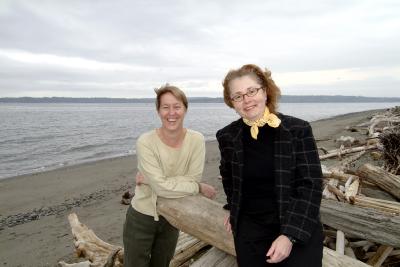April 29, 2004
Deadly algae blooms to be studied at new UW research center
Algal blooms in Puget Sound and off the coast are increasingly producing domoic acid, which can sicken and — in high enough doses — kill humans, other mammals and birds when they eat fish or shellfish contaminated with the toxin.
These toxic blooms will be the focus of a new national research center — the Pacific Northwest Center for Human Health and Ocean Sciences — at the University of Washington.
With funding of $6.4 million for five years from the National Science Foundation and National Institute of Environmental Health, the center will focus on understanding the environmental conditions that trigger blooms of harmful algae in marine waters and ultimately, how these blooms affect public health if contaminated seafood is eaten, especially by sensitive populations such as children.
“This is the first time that the National Science Foundation and National Institute of Environmental Health have partnered to jointly fund such important multidisciplinary research,” said Elaine Faustman, UW professor of environmental health and director of the new center. “The UW Center will provide a unique opportunity for experts in public health and oceanographic sciences to work together to study the effects of harmful algal blooms.”
Co-director of the center is Ginger Armbrust, UW associate professor of oceanography.
The federal agencies are expected to invest $5 million annually for the next five years to support the center at the UW, as well as just-announced centers at the University of Hawaii, Woods Hole Oceanographic Institution in Massachusetts and the University of Miami.
At the UW, the interest is in diatoms, which are central components of healthy coastal ecosystems. However, some species produce the marine toxin domoic acid. Eating food contaminated with domoic acid can result in amnesic shellfish poisoning, a neurological illness. Acute exposure can cause such things as permanent loss of short-term memory and sometimes death. In lower doses, it may cause gastrointestinal distress and nausea. There is no antidote.
Alfred Hitchcock’s movie thriller, The Birds, which depicted flocks of birds attacking people, was based on a historical incident in Capitola, Calif., where birds ate sea life that was probably contaminated by domoic acid and then attacked townspeople.
Since the 1991 discovery of domoic acid along the Washington coast, samples of shellfish have regularly been collected and analyzed by the Washington Department of Fish and Wildlife, tribal nations and the Washington Department of Health. When levels are too high, beaches are closed to harvesting. Fish and wildlife posts alerts at http://wdfw.wa.gov/fishcorn.htm.
Increasingly since 1991, Washington beaches have been closed to razor clam digging after domoic acid concentrations rose above federally accepted levels. Last September, commercial shellfish beds near Port Townsend were closed, the first domoic acid-based closure on Puget Sound.
Along with faculty and students from the UW’s College of Ocean and Fishery Sciences and School of Public Health and Community Medicine, the center will have investigators from the National Oceanographic and Atmospheric Administration, the Washington State Department of Health, the Washington State Department of Ecology, Institute for Systems Biology and the University of Maryland. Key questions will include:
• What environmental factors lead to development of toxic blooms and what determines the levels of toxicity within these blooms?
• Why do certain types of shellfish retain the toxin while others appear to quickly eliminate it?
• What are the molecular mechanisms of domoic acid toxicity and what genetic, age- and dose-related factors define susceptibility?
• What populations are at greatest risk based on age, cultural practices and geographic proximity to contaminated shellfish?
• What dietary and consumption behaviors contribute to exposure? ]
In addition to research, the center also will provide the public with information about potential health risks from domoic acid.



